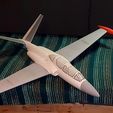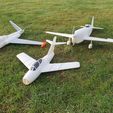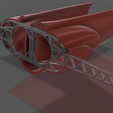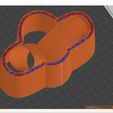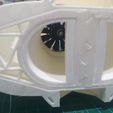In these test files you will find the not too large piece of F6, which shows the structure of the fuselage parts.
Also included are W2 and W3, a wing part and aileron to clarify the operation of the hinges. You will then find the hinge pegs in the file PLA+ parts. In the 3MF file you can delete the remaining parts and only print the hinge pegs.
The fuselage part W4 and the wing joiner are also included to clarify the mounting of the wing to the fuselage.
The well-known Fouga Magister, used as a jet trainer by many countries for many years. After 47 years of loyal service, the Fouga made its last flight in Belgium in 2007. I not only wanted the image of the flying Fouga in my memories, but also wanted to experience it. That's why a few years ago, encouraged by some friends at the club, I designed a 2M Fouga with 90mm EDF in Foam. This Fouga is still one of my favorite planes and is still flown often. Still, I wanted to fly the Fouga even more, so I made it smaller with a 50mm EDF designed for the 3D printer. The wings are easily removable, but the Fouga also fits in most cars with mounted wings, ideal for quick flights, take out of the car and fly.
As with my other designs, the Fouga is also constructed with infill for most parts. Due to the experience gained from previous designs, the parts become lighter and the model becomes easier to build with lesser parts used. With the Fouga I also managed to avoid using Carbon. The wings are firmly attached to the fuselage by a wing joiner printed in PLA+. The Fouga wing is also strong enough without the use of carbon wing spars. This makes the wing a bit more flexible, but it has held up so far and can withstand all aerobatics. However, the possibility is provided to glue in a wing spar.
As an EDF, an XFLY model 50mm for 4S fits perfectly, other brands will probably also fit with or without minor adjustments.
A battery from 4s 1800 to 2600mAh can be used, I have flown the Fouga up to a light 4S 3000mAh, there is plenty of room under the canopy and the battery can be moved comfortably to adjust the CG. The Fouga can tolerate the extra weight without any problems and with the larger batteries, flight times of more than 6 minutes are possible.
A bungee is recommended as a starting aid, hand launch is also possible but is risky.
Important!
I have tested the Fouga extensively and printed it with the files I put online.
I have included a concise manual, but experience in building and flying RC planes remains a requirement.
I therefore also assume that anyone who ventures to build the Fouga is aware of this and takes the responsibility for whether or not the Fouga being built and flowing correctly.
The Fouga is a wonderful airplane to fly, and I also hope that you like the way it has been constructed.
However, although the real Fouga was a jet trainer, although it flies easily, the Fouga is not suitable for learning to fly RC planes.
There are more suitable models on the market for this. Don't try to skip this step of learning to fly properly first, it will save you a lot of frustration, time and extra costs, and afterwards you will have more fun flying your RC planes.
Wingspann: 1100mm
Weight: 900-1000gr
EDF: 50mm 4S
Batt: 4s 1800-2600mAh
ESC: 40A
Seros: 4x 8mm servos

